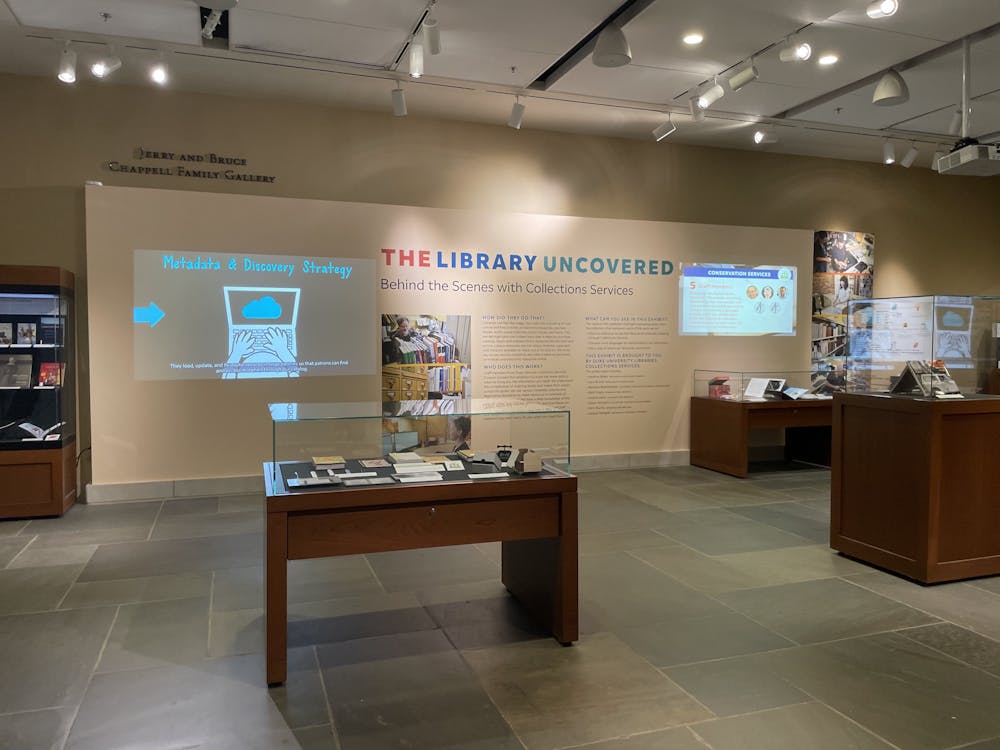Have you ever seen a library book stained with spilled coffee encased for public viewing?
The exhibit case, which explains the repair of broken or damaged books, is part of the newest library exhibit in the entrance to Perkins Library, titled, “The Library Uncovered: Behind the Scenes with Collection Services.”
The exhibit required collaboration from all departments of the library, bringing the whole library together to make an exhibit about how to run a library.
The Jerry and Bruce Chappell Family Gallery houses the new exhibit, which includes 10 exhibit cases and a map of all Duke book vendors around the world. Six members from each of the different library departments curated one or two display cases each.
Meg Brown, head of exhibition services, and Beth Doyle, head of conservation services, spearheaded the project. The idea was originally formed out of necessity — no one wanted to commit to curating an exhibit during COVID-19. But it evolved into a method to display the behind-the-scenes work of the library services.
Each exhibit case focuses on a different aspect of the job, including, “When disaster strikes,” “Scanning for public access,” and “Cataloging a world of languages."

“The library doesn’t just happen,” Brown said, in reference to the interdepartmental collaboration required to provide any library services a student might need.
The exhibit space also features two projectors, one with a video made by Senior Conservation Technician Jovana Ivezic, detailing the different departmental staffs and purposes.
“I just hope that [viewers of the exhibit] have a better appreciation for what goes into making a library function,” Ivezic said.
The Chappell Gallery exhibit changes every six months.
“It's designed as a space to reflect Duke,” Brown said.
The previous exhibit explored the history of the Ar-Razzaq Islamic Center, the first known Mosque in Durham. Before that, the exhibit was “Our history, our voice: Latinx at Duke,” curated by four Latinx courses and two different faculty members.
The following two exhibits will center around Duke’s centennial and a look back at Duke’s past 100 years.
The library’s expansive collection
The Chappell Gallery is just one of the seven major exhibit spaces hosted at Duke’s various libraries. However, given that the Chappell Family Exhibit is at the entrance to Perkins, it gets a great deal of foot traffic and is the most visible.
“I like to think probably 10% of the people will stop at some point and look at something,” Brown said.
Across the hall from the Chappell Family Gallery is a grandiose entrance, with a sign inviting people to view the exhibit.
Get The Chronicle straight to your inbox
Sign up for our weekly newsletter. Cancel at any time.
The exhibit features three major spaces: the Mary Duke Biddle Room, the Stone Family Gallery and the Trent History of Medicine.
The highlights from the exhibit include Audubon books worth over $1 million, an exhibit paying homage to Duke’s tobacco history following a pre-COVID ban on smoking, Virginia Woolf’s writing desk and an old collection of cardiological medical tools. The Stone Family Gallery includes a great deal of classwork in collaboration between the students and the library.
Immediately outside the exhibit a stone pathway takes a library-goer to the Rubenstein Library Photography Gallery.
“Each of our galleries has a slightly different mission,” Brown said. “This one is to support and share with the community our documentary collection.”
The current Rubenstein Library Photography exhibit, “No Longer Can I Stay; It’s True,” documents the lives of the people of the Bikini Atoll who were relocated due to nuclear testing. They faced starvation and instability and today are still unable to return to their now uninhabitable home.
Behind the scenes
Down the back stairs to the basement of the library doesn’t just house the Link: it is also home to the conservation workshop. The library services are split between the lower level of the library and Smith Warehouse.
The Conservation Lab is where books are transformed. As described in the “Repairing Our Books by Hand” and “When Disaster Strikes” displays in Perkins, the Conservation Services team repairs damaged books to get them back up to the library.
The lab includes equipment to rebind, clean and preserve the materials in the library.

Past the lab space is the Digital Production Center, where library materials are scanned for the online database. Another room hosts the exhibit preparator, where materials are prepared for public display.
“We want the library, as a place, to be a part of [Duke students’] world,” Brown said. “We want the students to understand that the resources and the place are all a part of their experience and not a separate thing.”
“I guess it can be easy to forget that the library isn’t literally just books,” Ivezic said.

Jothi Gupta is a Trinity junior and an enterprise editor of The Chronicle's 120th volume.

